The GSD’s Early Design Education Programs: An Interview with Megan Panzano MArch ’10
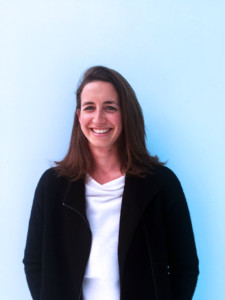
Megan Panzano MArch ’10
In 2021, the Harvard Graduate School of Design invested in a set of short introductory education programs that are directed at sharing the value of design with the global public. Early Design Education (EDE)—which invites different audiences to “think and make” through design—includes Design Discovery Virtual, Design Discovery in-person, and Design Discovery Youth summer programs; the Black in Design Mentorship program; and the Harvard Undergraduate Architecture Studies program.
Last June, Megan Panzano MArch ’10 was named senior director of Early Design Education to lead these programs in refreshed formats into the future. Harvard GSD’s Joshua Machat talks with Panzano about her plans for the EDE programs that include breaking down access barriers to design education, engaging diverse perspectives on what should drive design, and building a robust support system for students and those new to teaching design.
The Early Design Education programs introduce design ideas and practices to a wide range of audiences on a global scale. What are the methodologies students will be engaged with concerning the impact of design on the built environment and its potential for societal change?
The programs offer a great chance to share the value of design with an expanded public, and reciprocally, to include and value the voices that a diverse public brings to design. We’re invested in these programs bringing new forms of design agency to the individual ideas and perspectives of our global participants. And we’re working on making these programs as accessible to as many people as possible.
The “early” part of Early Design Education is not an age-dependent term. Rather it assumes that each program is one of the earliest experiences of design immersion and “thinking through making” that participants—ranging from mid-career professionals to high school students—have encountered. These programs aim to offer thoughtful instruction in the materials and scale of design across architecture, landscape architecture, and urban planning and design; workshops in tools used for design, such as 3D modeling and graphics programs; and, most critically, how to think about the world through a design lens.
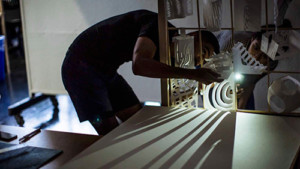
Harvard GSD Design Discovery Youth
The programs emphasize design as a method for asking important questions. The world is, and will continue to be, unavoidably instable—environmentally, politically, and socially. Our crafting of the Early Design Education programs accepts and claims that instability as a material of design. Rather than seeking a singular “right” answer or achieving a prescribed outcome, the programs teach how to use design to keep up with this evolution—to continuously question the world as we’ve come to know it. This happens by closely reading our context, seeing something that could be improved, naming it as a question, and directing design to impact it.
How has remote learning in the past two years impacted the EDE programs?
The required remote learning of the past two years has taught us many things, not all good. But there a few wonderful takeaways that we intend to hang onto. These positive qualities made it possible for us to conceive of a new format for our summer program, Design Discovery Virtual, which we will offer along with a refreshed version of our Design Discovery in-person program this summer and going forward. What’s been great is that now we have the chance to be intentional with constructing a virtual design education program, rather than simply reacting out of necessity of pandemic pressures.
We can easily bring diverse groups of people together from anywhere in the world to discuss design. That range of perspectives is incredible in conversation and as a way to expand one’s thinking. Within the context of our new virtual program, we note that peer-to-peer learning occurs as much as more conventional top-down organizations of learning from instructors.
Our virtual mode these past years has allowed us to learn and become quite good with programs, such as Miro and Slack, that make it easier to share work—both in-process as well as more polished—to collectively see and record design steps. Miro’s open virtual pin-up space visually collects elements in design processes and in works in progress such as drawings, 3D model images, design precedents and texts, and puts these on an equal plane with more complete finished final work for all members of a design studio. Because you can see your own design evolution beside those of your classmates, the program visually maps different learning paths along with design outcomes, a kind of meta level learning about learning. It’s a wonderfully powerful tool for those new to design.
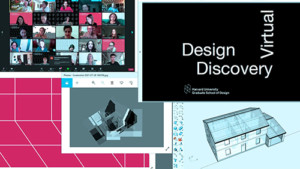
Harvard GSD Design Discovery Virtual
Sharing our ideas via virtual platforms requires us to be more clear and intentional with an argument and a narrative for our design work when presenting. As opposed to more conventional academic design presentations where a field of visual and modeled work would be pinned up and shown all at once to an audience, digital programs tend toward linearity of flipping through a presentation one slide after the next.
How do you see students in the Harvard Undergraduate Architecture Studies program benefiting from the interdisciplinary approach that teaches design “thinking through making” within the liberal arts context?
The Harvard Undergraduate Architecture Studies program is a special one within the EDE set because it is a joint endeavor between two schools at Harvard—the Faculty of Arts and Sciences and the Graduate School of Design. It’s a track of study within the history of art and architecture concentration, or major, at Harvard. The GSD has created and teaches four making-based courses annually as part of this degree of study. These courses draw architecture studies concentrators, but are also in high demand with computer science, engineering, history, and visual studies students. We teach architecture to undergraduates, not with the expectation that everyone will become a designer, but with the goal that those coming through our courses who go on to shape the world in any number of ways afterward, will do so with a true understanding of the value of design.
What new offerings are available in the undergraduate Architectural Studies program for students seeking more experience in design education?
I’m looking forward to launching a new version of a course that went on hold for the past two years: a lecture/workshop class next fall for Harvard College students on climate change, through design. The course will explore how material selection and construction practices could radically shift if driven by more sensitive and careful environmental concerns. The course will also study the formal and spatial outcomes of using entirely new building materials and assembly techniques.
It’s been a pleasure to have the support and enthusiasm of my colleagues in the History of Art and Architecture Department, David Roxburgh and Jennifer Roberts, to develop a process for students wishing to pursue a design thesis in their senior year at Harvard College. Going forward, this will be an honors-eligible option each year for our Harvard Architecture Studies students. I’m looking forward to working with more undergraduates pursuing design research on topics they are passionate about as an additional path of studying the impact of design on the important issues of today.
The EDE programs place a lot of emphasis on supporting design teaching opportunities for the current advanced students of the GSD. What are these opportunities and what structures are in place to develop teaching skills in design across all three disciplines?
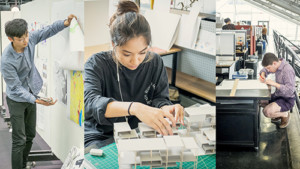
Harvard GSD Design Discovery
All of our EDE programs intentionally involve advanced GSD students as design instructors so that our current graduate students can gain design teaching experience, across all disciplines. We’ve been making some adjustments so that the programs in the EDE set call upon our GSD students to engage a different audience through different educational formats, and with varying degrees of agency to shape the design curriculum of the program. The intention is that the EDE programs provide a spectrum of design teaching experience that could build up if followed in sequence by current GSD students to help bridge them to post-degree academic positions. Our Design Discovery summer program, which has been around for more than 20 years, has a great track record of launching teaching careers in complement to design practice.
The Black in Design Mentorship program is rooted in the recognition that everyone benefits from mentorship, but not everyone has equal access due to racial inequalities and histories of disenfranchisement. What do you see as the most important factor in diversifying the design profession?
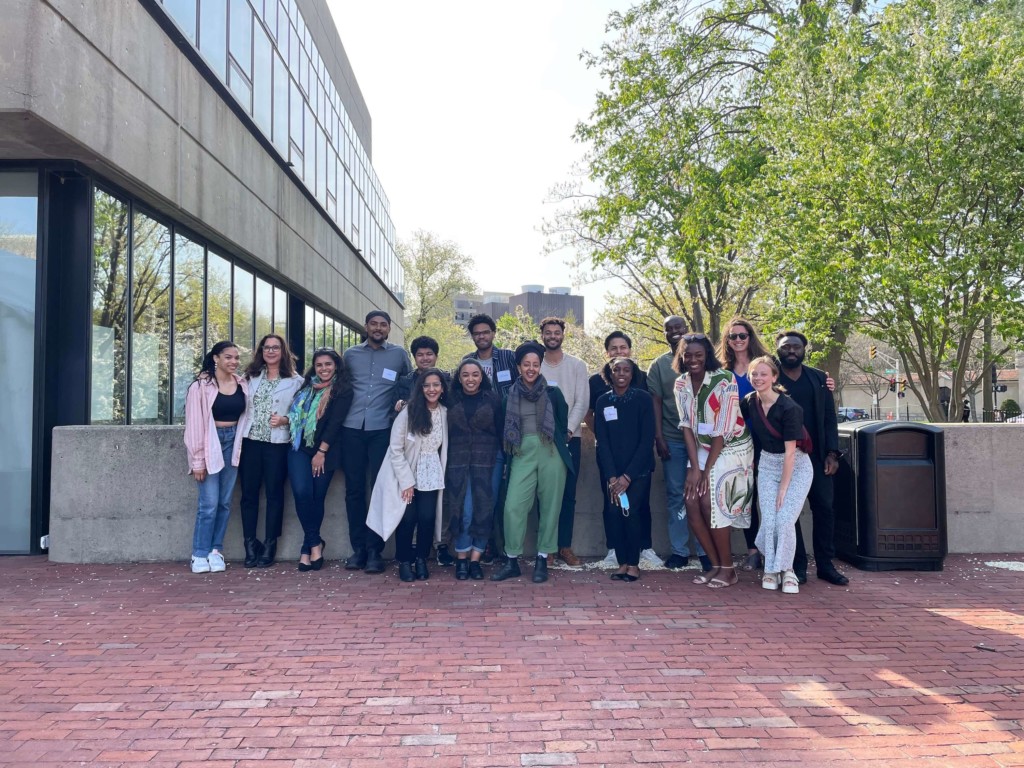
Members of the Black in Design Mentorship Class of 2022 visited Gund Hall in May to tour the building and celebrate the end of the program.
Recognizing and reevaluating what has been established, consciously and unconsciously, as “gate-keepers” to design is most pressing. This includes representation—seeing others like you in design and being able to project a path for yourself like theirs; affordability—considering the cost and time necessary for design education and professional licensure; geography—connecting design and its capacity to change the world as we’ve come to know it to the full range of global cultural heritages; and a sensitivity to the language we use to talk about design. If our profession is not appearing accessible to a diverse audience, one or more of those things are critically off. The design profession should be as diverse as the world we design within and for.
I’m honored to be working with a team of staff, students, and faculty who value these factors within the fields of design: Jenny French, Montserrat Bonvehi Rosich, Yun Fu, Kelly Wisnaskas, Ian Miley, Tosin Odugbemi, Rania Karamallah, Caleb Negash, Shaka Dendy, K. Michael Hays, and Sarah Whiting. Dean Whiting’s investment in Early Design Education has been critical in supporting the exciting plans we have to broaden design’s reach.
Story written by Joshua Machat for the GSD website.
